Abstract
Transport systems are essential for the path toward sustainable urbanisation and the transition to more sustainable living. Recently, European cities have undergone substantial changes, and suburbanisation is posing new challenges. Suburban areas are often more affordable in terms of housing, but these neighbourhoods tend to be car-oriented. This leads to higher commuter costs, immobility, transport and time poverty, pollution, higher accident rates and a lack of social interactions. To offer sustainable mobility options to citizens, we must comprehensively understand, together with their individual characteristics, their specific mobility practices and the built environment where they live. This study is centred on the Barcelona Metropolitan Region, which has a public transport network that covers its entire area. The aim of this study is to examine the relationships between travel behaviour, transport mode use, individual characteristics and built environment characteristics in the place of residence using detailed information sources. Herein, we used data from the 2018 to 2021 annual travel survey conducted in the Barcelona region, together with land use and sociodemographic information. Our findings suggest that transport policies have encouraged sustainable mobility practices, particularly in the centre of Barcelona. Despite the positive results, considerable disparities exist between the inner and outer city, with a notable decline in sustainable mobility practices in the latter, due to the uneven distribution of basic services and uneven provision of public transport, together with lower density areas. Our results demonstrate that this uneven distribution reduces the available sequence profiles of inhabitants. In conclusion, the promotion of sustainable mobility policies necessitates further advances in transport, city and land-use planning that consider equity, gender, the socioeconomic profiles of citizens and mixed urban planning.
1. Introduction
Urbanisation poses significant challenges with regard to sustainability. Notably, most of the world’s population is expected to live in cities by 2050. If, in 1968, Henri Lefebvre [1] called for “The Right to the City”, which advocates for city planning that considers public and social spaces that fulfil the needs of everyday life, the discussion has further evolved this concept into one that seeks for just, fair, diverse and inclusive societies in which the sustainability and health of all population groups are ensured but which also observes climate change mitigation, resilience and adaptation policies [2,3,4]. The 2030 Sustainable Development Agenda and the New Urban Agenda [5] call for the promotion of sustainable urbanisation. In this respect, authors have highlighted that providing access to goods and services in a universal manner is of utmost importance [3].
On the path towards sustainable urbanisation and the transition to more sustainable lifestyles in cities, transport systems are essential components. Transportation is crucial for exercising our Right to the City by facilitating our daily activities and influencing our quality of life. Transport enables us to commute, work, learn, produce, buy and sell, gather information, meet our energy needs and participate in cultural, health and social activities. Additionally, both the built environment and technological innovations shape our mobility practices [6]. In this respect, new mobility alternatives, such as micromobility and transport on demand (MaaS), have also impacted our urban spaces and influenced the way we move [7,8].
However, transport systems and built environments are not the only factors that shape our mobility, our personal characteristics, including age, gender, origin, religion, disability and income influence how we move [9], conditioned also by the connectivity of transport systems, the modal choices they offer and their accessibility.
In Europe, cities have evolved, and suburbanisation is posing new challenges. Poverty is moving out of city centres and “decentralising” to city outskirts as a result of not only increasing populations but also income inequalities, a lack of social housing, combined with market-oriented housing policies, gentrification, and urban segregation [10,11,12]. Car-oriented neighbourhoods pose different challenges in terms of higher commuter costs, immobility, transport and time poverty, pollution, accident rates and lack of social interactions [13].
Recent breakthroughs achieved with 15-, 20- or X-minute cities (also known as chrono-urbanism) highlight the idea that mixed-land-use neighbourhoods provide citizens with convenient opportunities and ease access to activities while substantially reducing the number of unnecessary trips and fostering sustainable mobility, which positively impacts citizens’ well-being. However, important disparities remain in service provision, land-use planning and transport alternatives among neighbourhoods [14,15].
For these reasons, the opportunities that transport systems, especially sustainable transport systems, provide to different population groups must be analysed on a finer scale according to their different individual socioeconomic characteristics and the spatial distribution of services.
In Barcelona, the analysis of 2018, 2019, 2020 and 2021 travel surveys by the Metropolitan Transport Authorities in Barcelona (commonly known as EMEF travel surveys) constituted a preliminary analysis of the spatial effects of travel behaviour [16,17], exploring the connections between declared modal use frequencies (i.e., generic modal preferences), individual characteristics and place of residence. The results indicate high levels of public transport use, together with limited car use by residents of Barcelona city (BCN). In contrast, frequent car use and nonactive modes were found in the outer Barcelona Metropolitan Region (RMB).
The clear spatial dependencies between individual characteristics (such as gender), transport mode use and areas of residence (including land-use and built-environment indicators, as well as indicators related to the sequences of activities of trip-makers) motivate this study, with the aim of gaining deeper insight into these dependencies.
To date, studies on individual, socioeconomic and spatial dependencies have only considered broad areas within the RMB. Therefore, a more detailed analysis using finer-scale spatial units is necessary. Traffic analysis zones (TAZs) commonly used in transportation analysis offer new opportunities and provide additional information for official travel surveys such as information on socioeconomic level, land use, accessibility and urban form.
This study presents a more comprehensive study of mobility choices considering land use and personal characteristics. The aims of this study are multiple. We apply the methodology of sequence analysis (SA) to the EMEF 2018–2021 surveys combining this dataset with land use, built environment, accessibility, and other socioeconomic data to gain further insights into mobility behaviour. Herein, we assess several individual and sociodemographic characteristics, including gender, education and economic level, among others, together with a finer-scale land use distribution in the RMB. Likewise, we analyse mobility similarities and dissimilarities depending on the individual’s profile using a clustering analysis. Furthermore, we evaluate whether fragmentation indicators are relevant in the clustering of TAZs, how gender influences mobility practices and the effect of years on the sample.
Compared to other studies that used the same sequence analysis methodology, we fill a relevant gap in research. Exploiting the complexity of a multimodal transport system in the metropolitan urban area of Barcelona, we include multiple modal possibilities as parts of the potential “states” during daily activities. Until now, previous studies have only included a set of activities based on travel purposes, but they did not consider the travel mode alternatives as parts of the sequence “states”.
We strive to contribute to the future development of an enhanced activity-based demand model for the RMB. As evidenced by authors such as Rasouli and Timmermans [18], travel surveys (as exemplified by the one used in this study) are primary requirements for developing activity-based travel demand models that order activities and trips across time and space. The further development of these models can serve as a foundation for tailored transport policies.
The remainder of this study is structured as follows: Section 2 presents the literature review; Section 3 introduces the case study and its characteristics, together with the data and methodological approach; Section 4 displays the results of the analyses carried out; and, finally, the main conclusions are drawn in Section 5.
2. Literature Review
The interest in activity fragmentation has increased over the last decades because of many different factors. Recently, information and communication technologies (ICTs) have increased opportunities to engage in flexible daily activities, especially for some population groups [19,20,21].
Furthermore, it is worth noting that over the past decades, a debate concerning the “neuter commuter” in transport planning, urban geography and feminist studies has arisen [22,23]. The need to move beyond the traditional roles of women in private spaces and men in paid work has been emphasised many times [9,24]. Similarly, assessing the characteristics and differences in women’s travel patterns has also been highlighted in multiple studies [25,26]. Creswell and Uteng [25] observe that feminist geographers and other research groups have pointed out that women are less likely to have direct daily travel pattern trips than men. Clearly, the analysis of home–work trips has a limited scope compared to the broader spectrum of activities and places visited during the day. More recently, proximity to basic services was highlighted as a fundamental part of the chrono-urbanism concept [14]. The former issues increase the need for other methodologies to conduct mobility behaviour analyses.
Sequence analysis was developed for use in the social sciences to understand how events occur over life trajectories [27], with some events occurring rarely and others in a recurrent manner. This analysis approach allows for encoding different “states” to understand duration, recurrence and similarities with other individuals [28]. This approach was recently applied to analyse the spatiotemporal organisation of daily activities among different geographical contexts [16,29,30,31]. The following section presents a detailed overview of this approach.
2.1. Sequence Analysis
Sequence analysis (SA) aims to understand the occurrence of activities or events in a structured way. A sequence is defined as a list of events and actions that occur in an ordered manner. Many authors have developed these concepts and methodologies over the years [32,33,34,35,36]. As observed by McBride et al. [37], the analysis of sequences of daily episodes (including places and trips) is an approach that may be considered preferable to other techniques, as sequences include the entire trajectory of an individual’s activities throughout the day, while at the same time, it is possible to evaluate the number and order of activities, together with their durations.
Studer and Ritschard [28] identified the following inextricably linked key characteristics: experienced states, distribution, timing, duration and sequencing. Sequence analysis has proven to be a relevant approach to travel behaviour analysis, as it describes the fragmentation of activities and daily patterns as a string of activities and transitions from one state to the other, which includes the amount of time spent engaging in each activity and the trip details [38].
Sequence analysis studies have recently been conducted in analyses of travel behaviour [38,39,40] and many of them have focused on fragmentation. For example, Hubers et al. [29] observed that teleworking and temporal fragmentation vary among individuals with different sociodemographic characteristics. Researchers have noted that gender also plays a role in fragmented schedules [16,29,41]. Recently, Cheng et al. [31] used this approach to assess work activities at three different location categories using information from the American Time Use Survey from 2003 to 2020. These authors observed that during the COVID-19 pandemic, the spatial fragmentation changed because of the restrictions, but the temporal fragmentation differed among those working from home. Furthermore, fragmented work differs according to sociodemographic characteristics. Similarly, Shi and Goulias [30] used data from 2019 to 2022 to investigate the impact of the COVID-19 pandemic on travel behaviour in the USA.
Although many indicators can be used to represent state sequences [27], only a subset is relevant for travel behaviour analyses. The most applicable and extensively used indicators within this domain are entropy, turbulence, complexity, and travel–time ratio [42,43,44]. These indicators facilitate the analysis and measurement of activity durations and transition rates among them, offering insights into the diversity and intricacy of sequences. Here, an activity sequence comprises a list of states specifying the activity/state applicable for every minute in a day [45].
Table A1 in Appendix A provides the main details of the different indicators used in this study, together with the relevant references.
2.2. Cluster Analysis
Clustering analysis is often used to group observations on the basis of different parameters. It is a fundamental exploratory technique in data science. Its goal is to highlight certain similarities and dissimilarities among observations in a dataset to unveil a set of categories, which become the main groups of interest and the objects of study [46,47].
Different studies in the field of transport behaviour have used this approach to analyse population similarities or differences. For example, McBride et al. [37] clustered representative daily behaviour patterns, and Shi et al. [38] analysed groups of observations with similarly high or low fragmentation. Lenz and Nobis [48] investigated groups exhibiting different fragmentation behaviours to analyse the relationships with ICT use. Furthermore, von Behren et al. [49] carried out an image-based clustering analysis of individuals’ pattern segmentations using the German Mobility Panel.
Many studies on travel behaviour have highlighted the connections between travel mode, individual sociodemographic characteristics and place of residence [17,50]; however, studies using sequence analysis to account for fragmentation indicators together with land use characteristics are limited, as [33]. The former opens new possibilities for land-use planning and transport policy. In this study, we aim to address this issue by analysing the connection between mobility behaviour, land use and individual sociodemographic characteristics, together with sequence analysis, using the Barcelona Metropolitan Region as a case study.
3. Research Data and Methods
The Barcelona Metropolitan Region (RMB), which is used as the case study, is depicted in Figure 1. The RMB, with more than 5 million inhabitants, covering 3200 km2 and including 164 municipalities, is connected by a dense public transport network including more than 200 bus lines, 4000 bus stops, 10 metro lines, 15 train lines, and two tram lines. During a working day, approximately 17.5 million trips are made in the RMB.
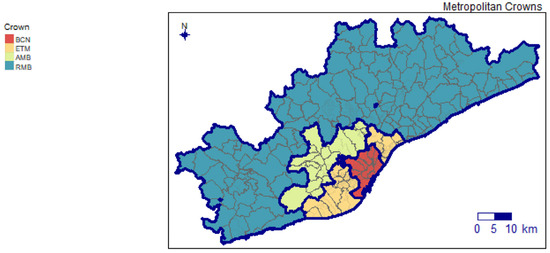
Figure 1.
Metropolitan Region of Barcelona: “Crowns” and TAZ-EMEF.
Figure 1 presents the main areas into which the RMB is divided. The city of Barcelona (BCN) is divided into 10 districts (highlighted in red), the primary crown of the RMB (in orange), the rest of the Barcelona Metropolitan Area (AMB) (in light green) and the rest of the metropolitan region (in turquoise).
On the one hand, information from the Mobility Observatory in Catalonia [51] shows differences in mobility according to the purpose of the activity as follows: mandatory and discretionary mobility account for 39.8% of the trips, whereas mobility for work purposes accounts for only 17.5% of the daily travel patterns. The rest of the trips are return trips to home (42.7%).
On the other hand, mobility by private vehicle increases as the area of residence moves away from Barcelona city, whereas active mobility and use of public transport decreases. Residents of the Barcelona municipality use public transport for 24% of their journeys, whereas residents of the remaining areas in the RMB use it for 8.7% of their weekday trips. It is worth noting that in the case of trips within the Barcelona Municipality and those carried out between Barcelona and the rest of the primary crown (ETM), there are more trips taken using public than private transportation, with ratios of 180/100 and 117/100, respectively.
Figure 1 shows the boundaries of the 173 Traffic Analysis Zones (TAZs) into which the region is divided, corresponding to the EMEF surveys analytics [52]. The TAZ-EMEF macrozones correspond to an aggregated zoning system, organised as follows:
- The Municipality of Barcelona is divided into 10 macrozones, “TAZ-EMEF”, each corresponding to a district, as highlighted in Figure 1;
- In the RMB, each macrozone accounts for one municipality.
3.1. Study Data
In this study, we made use of socioeconomic data, finer-scale population data, services and other characteristics of the built environment necessary for an accessibility analysis. These data, named the TAZ-EMO zoning system, are also used in the zoning system for the Visum model [53] (PTV AG, Karlsruhe, Germany) in the RMB study. In the TAZ-EMO zoning system, the RMB is divided into 850 zones. Therefore, a data orchestration process is required to aggregate the TAZ-EMO information on the scale of the TAZ-EMEF, which is henceforth referred to as TAZ.
In summary, the following two sets of data sources were used:
- Data directly associated with each TAZ-EMO and data available from the local transportation authorities (Autoritat del Transport Metropolità, ATM, Barcelona, Spain), land registry system and Catalan Institute of Statistics (population census), as well as transport-related data available in GTFS documents. The land-use variables included were residential, commercial, industrial and other areas with services, using the roof area (m2) measured for each TAZ-EMO. Moreover, residential areas were divided into the following four types according to the terminology used in Barcelona for the different districts: old quarter, urban block (for example, Eixample neighbourhood), isolated blocks (found in suburban areas, such as l’Hospitalet de Llobregat), and individual detached and semidetached houses (for example, in Sant Cugat del Vallès). The sources of land use, transportation and socioeconomic data are provided in Table A2.
- Individual-level data from the Regional Transport Authority (AMB) (EMEF travel surveys) for the years 2018 to 2021, including age, gender (men and women only in the collected data) and education level.
3.2. Data Processing
First, the variables based on the TAZ-EMO data were grouped at the TAZ macrozone level in blocks V1 to V14, as indicated in Table 1 (see Table A2 in Appendix A for details on the land-use and built-environment data). Some of the variables derived from the TAZ-EMO data were the results of the data orchestration process, which combined data from zones of finer partitioning (TAZ-EMO) to macrozones in accordance with the EMEF surveys used in this study; therefore, the corresponding variables were computed in terms of weighted means, which has proven useful, similar to the findings of other authors [15,52].

Table 1.
Description of the study variables.
The variables in blocks 17 to 20 were related to fragmentation indicators, as shown in Table 1. The aim of these indicators is to comprehend the intricate nature of individuals’ activity sequences. Fragmentation indicators were calculated for each sample unit (individual) from the data available from the 2018 to 2021 EMEF surveys, which were then regrouped at the TAZ macrozone level and by year, accounting for expansion factors.
3.3. Methodological Approach
The resulting dataset had n analysis units, each being a TAZ unit, resulting in n = 154, with large amounts of data for all four years and two sets of variables for each unit, with the first set corresponding to the TAZ variables in blocks V1 to V14 for a total of m1 variables, and the second set corresponding to the variables elaborated from the annual EMEF travel surveys in blocks V15 to V20, with a total of m2 variables. The resulting dataset of n (m1 + m2) was large enough to require the use of special data analytics techniques to extract information. Therefore, the applied methodology consisted of the following steps:
- Dimensionality reduction was performed by applying principal component analysis (PCA) based on the FactoMineR library [55,56] using the RStudio statistical platform [57].
- Afterward, the identified principal components were interpreted in terms of the contributions of the original variables.
- Hierarchical clustering analysis [56,58,59] was conducted in the space of the principal components to cluster the zones in terms of the similarities based on Ward linkages [60], as defined by the corresponding variables from the cluster profile analysis. The clusters were profiled according to the statistically most significant numeric variables and factors of the zones included in the analysis, which was based on the catdes() profiling method of the FactoMineR [55] library in R/RStudio [54,57].
- The optimal number of clusters was selected either retaining at least 50% of the data variability or according to the silhouette plot [61].
- To increase understanding and facilitate the interpretation of the results, clusters were mapped in the RMB.
- The EMEF survey respondents, together with their TAZ macrozone details, were identified in correspondence with their spatial cluster information, according to land use and the built environment. Afterward, we conducted a second clustering refinement within each spatial cluster for EMEF survey respondents based on their daily sequences to analyse their mobility behaviours, leading to subclusters based on the SA.
Our initial hypothesis was that fragmentation indicators play critical roles in the spatial clustering of the TAZs, together with year independence. To test the previous hypothesis, the proposed methodology was applied in the following two distinct analyses:
- The base analysis, defined in terms of the variables that were considered as neither gender nor fragmentation variables and located in blocks V1 to V14.
- The full analysis, including both the base analysis variables plus the modal uses according to gender (blocks V15 and V16) and gender fragmentation (blocks V17 to V20). The fragmentation indicators (see Appendix A for further details) were computed from the analysis of minute-by-minute sequences using the TraMinerR package [43,62] in RStudio [57].
4. Results
The following subsections provide the main details of the study’s outcomes for the base and full analyses.
4.1. Base Analysis Results
The principal components are linear combinations of the original variables. Dimensions 1, 2, 3 and 4 are the axes defined by principal components 1 to 4 (PC-1 to PC-4), which are linear combinations of the referred to variables, whose coefficients for this analysis are provided in Table 2. Using the years 2018 to 2021, the variables contributing the most to the first four axes were as follows:

Table 2.
Contributions to the first to fourth dimensions in the PCA.
- Axis 1. The first axis was positively related to population levels, jobs numbers, mixed land use/land use diversity and the number of bus, metro and commuter rail stops within each TAZ. This axis was negatively related to the mean travel time, at either the CBD or regional levels.
- Axis 2. The second axis was related to increasing travel times, for either any part of the metropolitan region or the CBD and the number of train stations.
- Axis 3. Percentage of dwelling areas in the zone.
- Axis 4. This axis was positively related to increases in the distance to access public transport facilities and increases in per capita income.
Figure 2, Figure 3, and Table 2 show the results of the base analysis. They present the contributions of the variables in the first to the fourth axes, graphical representations of the principal components (PC1 to PC4) in the space defined by the factorial axes (left—dimensions 1 and 2; right—dimensions 3 and 4) and the resulting spatial clustering of the TAZ macrozones. Nine clusters were needed to retain 50% of the data’s variability.
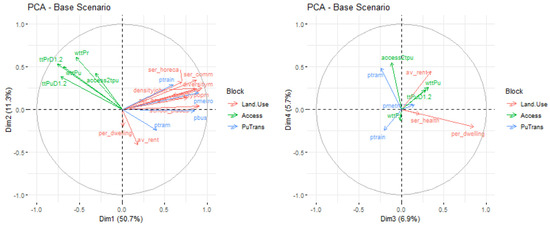
Figure 2.
Principal component analysis (base analysis): (left) dimensions 1 and 2; and dimensions 3 and 4 (right).

Figure 3.
Base analysis: spatial clustering of the TAZs.
The cluster analysis indicates that the most important variables associated with the cluster definition were population density, mixed land use, job density, and number of public transport stops.
- Cluster 1. Municipalities in the rest of the RMB with low population densities and low land-use mix. Travel times to the CBD were above the mean in the RMB, either by private or public transportation, but access to public transport facilities was good. Public transport use was lower than the overall mean in the RMB.
- Cluster 2. The share of public transportation was less than the overall mean in the RMB. Although access to public transportation facilities was lower than the mean, bus stops were scarce.
- Cluster 3. Municipalities characterised by high residential use, a mean per capita income above the mean, short access times to public transportation facilities and good commutes to the CBD by car.
- Cluster 4. High incidence of detached houses, extensive use of nonmotorised transport modes and good access to the CBD via public transport.
- Cluster 5. A high share of public transportation, good access to the CBD via car or public transport and containing municipalities in the first crown (ETM).
- Cluster 6. Well-served by trains, with a high incidence of tertiary sector land use (e.g., businesses and restaurants) and higher mixed land use/land use diversity than the overall mean.
- Cluster 7. Municipalities with high population densities and land use diversity. They are well-served by buses and the metro. The number of bus stops is greater than the mean and the travel time to the city centre of Barcelona is less than the mean, either by private or public transportation. It is characterised by the traditional old city building type and contains municipalities in the first crown (ETM) and seven districts in Barcelona city.
- Cluster 8. Represented by many suburban neighbourhoods, with high-population and high land use diversity areas. It includes many schools/kindergartens and restaurants. The share of public transport was above the mean. This cluster also includes the “Sant Martí” and “les Corts” Districts located in Barcelona city.
- Cluster 9. Characterised by higher population and job densities and high land use diversity. It is well served by the metro, and the share of private transport is very low. It contains the “l’Eixample” District of Barcelona city and “l’Hospitalet de Llobregat”.
4.2. Full Analysis Results
The principal components (PCAs) are linear combinations of the original variables considered in the second analysis, including variables V1 to V14 (including land use, employment, socioeconomic characteristics, accessibility and transport mode preferences) and blocks V15 to V20 (including fragmentation indicators by year and gender, modal share and principal mode preference by gender). The variables contributing the most to the first four axes are as follows:
- Axis 1. The first axis is positively related to population level, job numbers and high land use diversity, as well as the number of bus, metro and public train transport stops, with a high percentage of public transport use. This axis is negatively related to mean travel time to the CBD, either by private or public transport. This axis contraposes the density of activities inside and around Barcelona’s urban area to the travel time to the city centre. Municipalities, Barcelona city zones and the primary crown are located (ETM) on the positive part of this axis;
- Axis 2. This axis is related to the increasing turbulence and complexity experienced in 2018 to 2021 on the positive part of the axis;
- Axis 3. The third axis is related to the increasing turbulence and complexity experienced in 2018–2020 at opposite ends of the axes, being positive for men in 2019 and negative for women in 2018 and men in 2020;
- Axis 4. The fourth axis is related to increasing fragmentation indicators related to 2019 and 2021 on opposite ends of the axes, being positive for women in 2019 and negative for men in 2021 and women in 2020.
Figure 4 and Table 3 summarises the contribution of the original variables to each factorial axis using graphs. They provide additional information relevant to the first principal component (first axis), because the socioeconomic and built-environment variables provide opposite contributions.
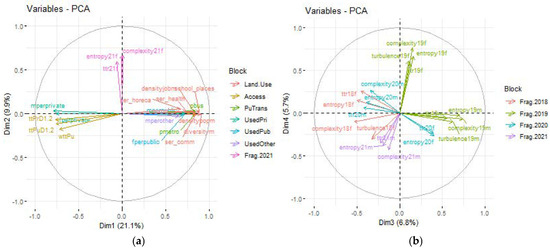
Figure 4.
PCA (full analysis): Contributions to the first to fourth dimensions in the PCA and variable projections: (left) dimensions 1–2; (right) dimensions 3–4.

Table 3.
Contributions to the first to fourth dimensions in the PCA (full analysis).
The clusters were profiled according to the most significant numeric variables and factors of the zones included in the clusters [56]. The number of clusters was set to explain at least 50% of the data’s variability. The most significant variables associated with the cluster definition were population density, mixed land use (diversity), job density, and number of public transit stops within the built-environment block (of each TAZ), as well as complexity and turbulence for women in 2020, and public transport and share of other transport modes. The characteristics of each cluster are summarised as follows:
- Cluster 1. Travel time, by private or public transport, over the mean. Public transport use and male fragmentation indicators above the means in 2020.
- Cluster 2. Entropy and travel times above the means for both men and women in 2021. Very low incidence of nonmotorised travel modes. Here, only one cluster was found, including small villages on the outskirts of the RMB, represented by the second-darkest blue in Figure 5.
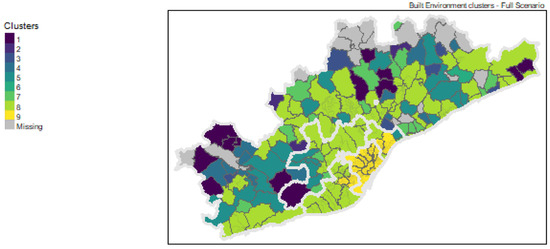 Figure 5. Full analysis: spatial clustering of the TAZs.
Figure 5. Full analysis: spatial clustering of the TAZs. - Cluster 3. Fully characterised by fragmentation indicators in different years.
- Cluster 4. Travel time by public transport and the share of private transport were very high. Turbulence and complexity were below the means in 2020.
- Cluster 5. Very high share of private vehicle use. Turbulence and complexity were below the means for women in 2020.
- Cluster 6. Turbulence and complexity considerably above the means in 2020, for both men and women. It only includes Vallgorguina, a municipality in the Montseny Natural Park area, north of the metropolitan area (third crown). During the strict COVID-19 lockdown measures in Spain, many residents in Barcelona temporarily moved to their holiday residences in this area (dark green in Figure 5).
- Cluster 7. Fragmentation indicators in 2019 and 2021 were above the means, and the private transport shares were also above the mean.
- Cluster 8. A per capita income below the mean and nonmotorised vehicle use above the mean. The cluster includes 63 municipalities, with medium-sized cities such as Sabadell, Terrassa, and Vilanova i la Geltrú (Figure 5 in light green).
- Cluster 9. Population level, job density and land use diversity above the means, including a high number of bus stops and services in general. It includes all districts in Barcelona city and the densely populated city of l’Hospitalet.
The spatial clusters in the full analysis were meaningful (Figure 5, light green and yellow). Barcelona city and the municipalities to the north (Badalona and Santa Coloma) and south (l’Hospitalet and Cornellà) form an urban continuum, densely populated and well-served by public transport. The south coast area is well-connected by train or bus to Barcelona city, and numerous commuters travel daily between these areas. The rest of the second crown in the interior contains Cerdanyola and Sant Cugat. These municipalities are extensively served by a local train to Barcelona, hosting many commuters every day. The rest of the third crown is diverse, but historical cities are included along the coast (Sabadell and Terrassa) and to the south (Sitges and Vilanova), which are well-served by train.
4.3. Full Analysis: Results Per Year
The justification for the third and fourth components was unclear, leading us to speculate that including all fragmentation variables for all years would introduce noise that could hinder the interpretation. If this was the case, a clearer picture would emerge if the analysis was repeated year by year, considering only the fragmentation variables for that specific year. Figure 6 and Table 4 show the contributions of the variables to the PCA by the year and their graphical representation in the PCA space, where stability can be noted across the years.
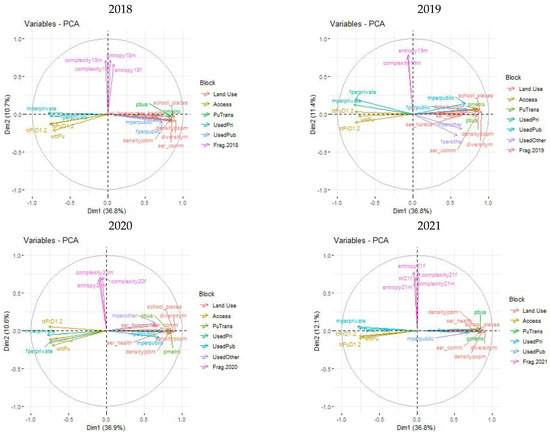
Figure 6.
PCA results by year. Data sources: 2018 to 2021 EMEF surveys, land-use and built-environment data.

Table 4.
PCA contributions per year and dimension.
The analysis presents the percentages of variance explained by the first four principal components per year, as follows:
- 2018: 36.8% (Dim 1); 10.7% (Dim2); 8.6% (Dim3); 7.0% (Dim4); 63.2% (Total);
- 2019: 36.8% (Dim 1); 11.3% (Dim2); 8.7% (Dim3); 7.1% (Dim4); 63.9% (Total);
- 2020: 36.9% (Dim 1); 10.6% (Dim2); 8.6% (Dim3); 7.1% (Dim4); 63.1% (Total);
- 2021: 36.8% (Dim 1); 12.1% (Dim2); 7:4% (Dim3); 7.2% (Dim4); 63.5% (Total).
The temporal stabilities, year after year, in the first and second principal components are remarkable. This is evidenced by the explained variance, which remained nearly constant, and the variables that contributed to the explanation of the component. The first principal component is influenced by socioeconomic, built-environment, and accessibility variables, whereas the second principal component is influenced by the fragmentation variables for each year. These results are highly consistent with those of the full analysis. The third and fourth principal components, which explain a marginal amount of the total variance, are explained by a mixture of variables. As a result, we decided to continue the analysis with the full set of variables.
4.4. Full Analysis: Revisited
A relevant issue in this study was the mode of transport most used by gender, where modes are classified between private (car, motorcycle), public transport (bus, metro, train and tram) and others (i.e., bikes, walking or e-scooters). Figure 7 shows the following notable differences between men and women: private modes are more often used by men than women; again, the south of the primary crown exhibits a different gender pattern (the corridor represented by the historic cities of Sabadell and Terrassa). Furthermore, both women and men used more public transport in the central part of Barcelona than in the rest of the metropolitan area, but the incidence differs among genders.
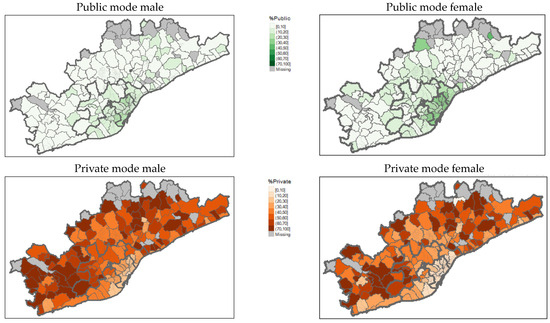
Figure 7.
Percentages of the transport modes used by zone and gender. Data source: EMEF data, 2018 to 2021.
In the central part of Barcelona’s area (primary crown/ETM), sustainable transport modes (public transport and others) were more likely to be used by women, whereas in the zones in the rest of the AMB and RMB (outer areas of the maps), the use of public transport was very low. Similarly, private transport was used less often in the primary crown than in the rest of the metropolitan area by both genders, but with different incidences. Nevertheless, men are more likely to use private modes in the central part than women.
The accessibility of public transport at the origin and the share of the transport mode were not homogeneous. The coverage by public transportation was nonuniform (upper Figure 8) in the metropolitan region; in the primary crown and some municipalities in the secondary crown, the density of public transport stops was high, indicating the extra travel time required when using public transport to reach Barcelona’s CBD (lower Figure 8) by zone.
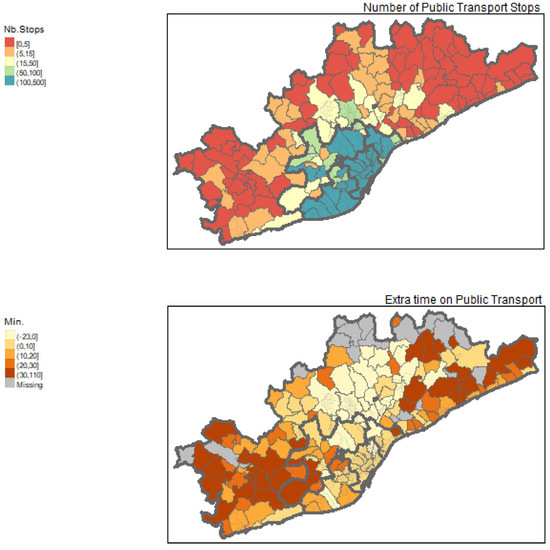

Figure 8.
(upper) Number of public transport stops by zone; (middle) extra travel time required when taking public transport to Barcelona’s CBD according to zone; (lower) transport mode shared by gender and number of public transport stops (with the y-axis as the discretised number of stops by zone).
The extra time required when taking public transport to Barcelona’s CBD was notable for noncoastal areas to the north and south, except for the Vallès corridor, and for historical cities that are well-served by a train. For any range of extra travel times required when using public transport compared with the use of private transport, the 95% confidence intervals of the mean entropy for men were greater than that for women. The confidence intervals did not intersect for the two groups, with a less than 10 min average difference between public and private transport modes. Extra turbulence in the women’s group was found for municipalities such as Sant Just Desvern, Matadepera, Premià, Teià, Sant Pol, Calella and Cabrera de Mar, which had high per capita incomes; these municipalities do not have adequate public services (public transport stops are sparse).
Figure 8 (lower) shows how the density of public transport stops influenced the use of public transport in the zones belonging to the crowns, whose borders are highlighted on the maps (upper and middle, Figure 8). Even in the case where the stops network is not dense, the percentage of private transport use was higher for men than women. Women preferred to use nonmotorised transport (the percentage use of other modes was higher than for men). Because women used public transport more often than men, we analysed the effect on the turbulence fragmentation indicator. The turbulence variability was greater for women than for men, and the mean values were also higher due to the differences in activity patterns according to gender (Figure 8, lower).
4.5. Optimal Spatial Clustering and Sequence Analysis (SA)
The three built-environment and land-use spatial clusters were determined according to the silhouette plot [63]. It proposes a partition based on three clusters. Figure 9 depicts the resulting clusters that highlight densely populated zones (in yellow, cluster III) in the first crown (EMT) and historical cities of Sabadell and Terrassa vs. medium-density zones (turquoise, cluster II) and mostly low-density areas (dark blue, cluster I).
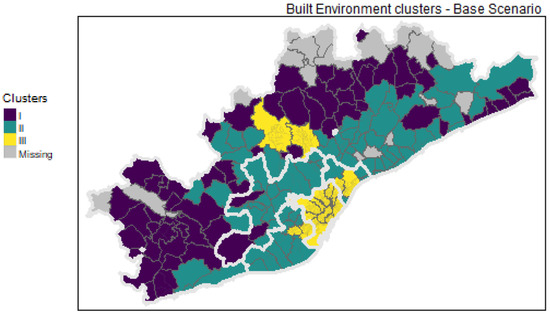
Figure 9.
Optimal spatial clustering according to the base analysis variables.
For each spatial area, hierarchical clustering of the sequences of travel behaviour in a day was performed leading to a set of subclusters for spatial clusters I to III (referred to as a spatial group below). The preliminary results for the densely populated subarea (including the first crown of the RMB) are shown in Figure 10.
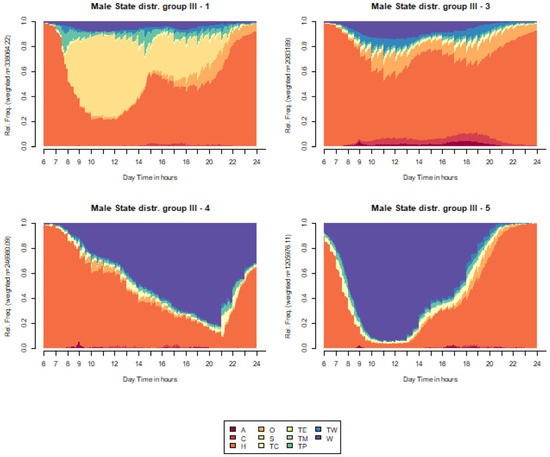
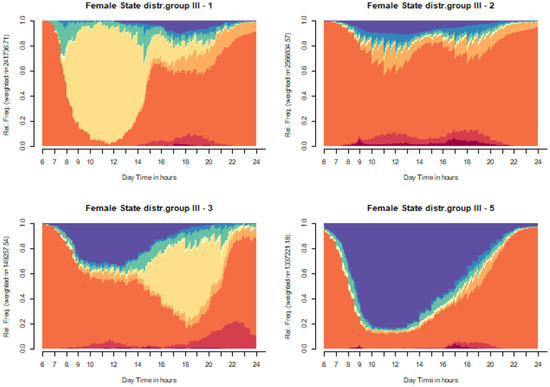
Figure 10.
State distribution of the activity sequences subclusters in spatial group III by gender ((top)—men; (bottom)—women). All years are based on EMEF survey data.
We analysed the transport purposes and transport modes defining 11 activities, including home (H), work (W), casual (C, infrequently visited places), other (O, frequently visited places outside of work), school (S, students only), escorting (A), and the following five travel categories: active (TW, walking and cycling), public transport (TP), travelling by car (TC), e-scooter (TE) and other travel categories (TM). The final analysis considered an alphabetical list of 11 activities. Both trip makers and non-trip makers were included in a sequence of 1,440 min or more (for example, those returning home after midnight), with each minute classified according to a travel activity category.
We focused on spatial cluster III (inner sections of Barcelona city, Sabadell and Terrassa), which showed a state distribution of the five SA clusters, allowing for an initial interpretation of the travel behaviour profiles represented by each cluster. State distribution is the proportion of the day invested in different activities. The main results are as follows:
- Cluster III. 1—morning-shift workers, some of whom extend their shift throughout the day;
- Cluster III. 2—afternoon-shift workers;
- Cluster III. 3—a low incidence of work activity is highlighted, and the incidence of home-based activities is notable, but escorting and other recurrent (not work) activities occur during the day;
- Cluster III. 4—partial morning work and afternoon educational activities via public transport;
- Cluster III. 5—morning educational activities that, in some cases, extend into the afternoon, with almost no incidence of work activity or other recurrent late-afternoon activities.
Figure 10 shows the daily state distribution of the activities in the sequences belonging to spatial group III, split by gender. Hierarchical clustering was repeated for each gender subsample and spatial cluster, and the four most remarkable clusters per gender were analysed. In the case of men, the characterisation was straightforward in spatial cluster III (densely populated macrozones), as follows: morning work-dominated profiles that extend throughout the whole daily period in cluster III.5; afternoon work-dominated profiles in cluster III.4; educational profiles in III.1; and home-based plus escorting profiles, including part-time work in cluster III.2. The relative incidences of the spatial group III clusters for men were 8%, 55%, 6% and 31% for cluster 1, 3, 4 and 5 (see Figure 10 top).
In the women’s clusters, the following characterisation was clear: work-based profiles that extended throughout the whole daily period in cluster III.5; afternoon educational and morning part-time work profiles in cluster III.3; morning educational profiles in cluster III.1; and home-based plus escorting profiles with limited part-time work in cluster III.2. The share of private transport by car was lower for the women’s than for the men’s clusters. The relative incidences in the spatial group III women’s clusters were 6%, 60%, 3% and 31%, respectively, for clusters 1, 2, 3 and 5 (see Figure 10 bottom).
Transport for escorting purposes in spatial cluster III accounted for a mean of 11.25 min (standard deviation: 48 min) for men and 14.52 min (standard deviation: 50 min) for women, and travel for work had a mean of 234 min (standard deviation: 266 min) for men and 186 min (standard deviation: 239 min) for women. The 95th percentile of escorting time was 70 min for men and 95 min for women. The 95th percentile of travel time by car was 120 min (mean: 29 min) for men and 85 min for women (mean: 15 min). The 95th percentile of travel time by public transport was 120 min (mean: 24 min) for men and 130 min for women (mean: 35 min). These figures and the incidence of home-based profiles in group III for men and women confirm the previous findings.
For a more detailed analysis of each spatial group, a subcluster refinement was carried out considering the individual daily sequences inside each spatial-based group (men and women together). These spatial groups (clusters I to III) were based on land-use and built-environment variables. Each spatial group was analysed in detail using activity sequences. As a result, SA-based subclusters were produced inside each spatial group.
The silhouette plots determined the optimal number of travel behaviour (SA) subclusters for each spatial group. The subclusters were two, three and five, respectively, for spatial groups I to III. Figure 11, Figure 12 and Figure 13 depict the percentage of the SA subclusters in each TAZ-EMEF.

Figure 11.
Percentage of SA subclusters for spatial group I.
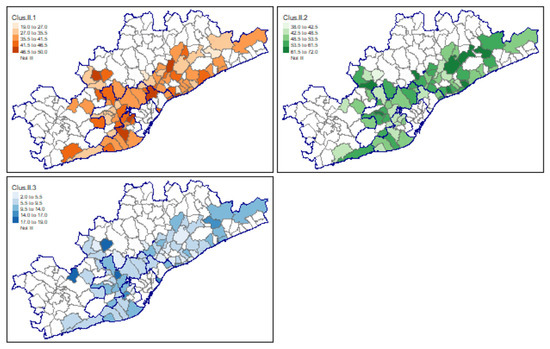
Figure 12.
Percentage of SA subclusters for spatial group II.
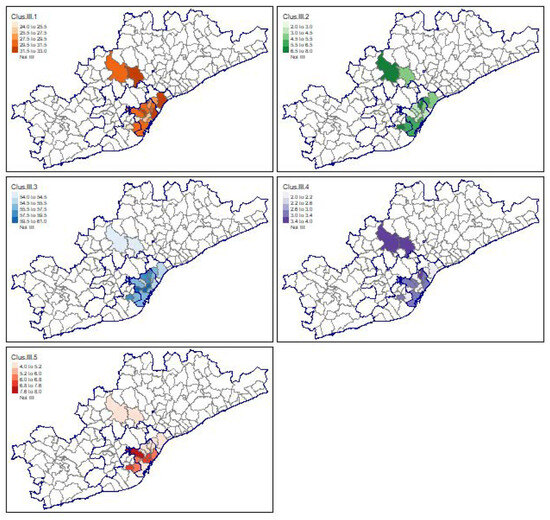
Figure 13.
Percentage of SA subclusters for spatial group III.
Although only two clusters are defined in group I (see Figure 11), in group III, there are five (see Figure 13). As previously mentioned, group III relates to central, dense areas in Barcelona; this group allows for the identification of five activity profiles, whereas in group I, on the outskirts of the region, the possibilities of encountering different profiles in activity patterns are reduced to two. Hence, the built environment increases or reduces the possibilities of having different activity profiles.
Furthermore, the results of the detailed analysis of each spatial group resulted in the following outcomes: the SA subclusters in spatial group I split the activity sequences into education-based (either mornings or afternoons) via public transport (cluster I.1) and work-based via private transport (mostly morning shifts), noting some immobility (home-based all day), whereby people did not engage in other activities. In spatial group II (Figure 12), work-based sequence activities using either private or public transportation are included in cluster II.1, whereas cluster II.2 includes home-based and other activities, with the notable use of active modes. Cluster II.3 groups daily education-based travel via public transport for both morning and afternoon shifts.
Cluster III.5, consisting of dedicated students, was over-represented in Sarrià, Eixample Districts and Barcelona city (upper socioeconomic level), whereas morning-shift workers were over-represented in Sabadell and Badalona (both densely populated cities in the RMB, with many commuters). Home-based activity was notable in Eixample and les Corts Districts, Barcelona. Travel pattern of part-time work and education was higher in the historical cities of Sabadell and Terrassa in the RMB.
5. Conclusions
In this study, we focused on how the built environment influences mobility patterns, considering individual characteristics and the spatial arrangement of the neighbourhoods in the metropolitan area of Barcelona. For this, we used a thorough dataset and different variables, including land-use, transportation, and socioeconomic variables, together with sequence analysis and fragmentation indicators. Compared to previous studies, in this study we included variables regarding the urban fabric and activities performed, together with selected transportation modes, an approach not typically used in sequence analyses found in the literature.
Our initial hypothesis was that fragmentation indicators played critical roles in the clustering of the SA sequences in the spatial groups defined for TAZs. This hypothesis was confirmed. Furthermore, they were found to be independent of the year, which confirmed the accurate combined use of all EMEF surveys between 2018 and 2021. The results confirm that different socioeconomic and spatial inequalities in the area, along with other factors influence travel behaviour. Sustainable transport modes are mainly used in the inner zones—Barcelona city and its primary crown—which was achieved through various policies and strategies related to sustainable mobility and urban planning (e.g., 30 km/h zones, low-emission zones and superblocks). However, our analysis suggests that sustainable transport options are barely used in the outer zones of the metropolitan area of Barcelona. According to the SA profiles, we observed that those in suburban areas are constrained to use private cars to commute because of the lack of accessible public transport, and these issues increase the complexity of trips from these areas.
Our results show that the built environment plays a key role in increasing or reducing the possibilities of having different activity profiles. Additionally, activity sequence clusters were different between men and women depending on the TAZ in which they lived and the spatial group (cluster) to which they belonged. In previous studies, activity sequence clusters, not considering spatial grouping, were not found to be as neatly characterised [52]
Furthermore, gender plays a key role in shaping mobility and sustainable mobility practices. Our results coincide with the literature review. In addition to the higher use of public transportation by women than men, men are more likely to use private cars to commute, even in the areas better served by public transportation. Furthermore, our findings confirm that women have shorter commuter trips to work than men and mobility for accompanying purposes is higher among women than men.
In this study, we observed important differences regarding gender, built environment and spatial characteristics of residential areas. These issues can be translated into policy recommendations, which should be analysed in detail. Clearly, demand-responsive transport (DRT), as a feeder of public transportation, should be used in areas lacking public transport infrastructure and captive to private transport (as shown in Figure 7, Figure 8 and Figure 9). The guidelines of the International Association of Public Transport (UITP) and the International Transport Forum (ITF) also highlight this approach [64,65,66,67], with the aim of achieving coordinated transportation systems that cover the gaps in public transit systems. The aim of this DRT should be to complement the public transport system instead of competing with it [63,68].
Similarly, policy interventions that seek to increase land-use mix, by increasing the number and diversity of basic services in suburban areas, may also reduce the complexity of daily trips and the use of private transport modes. Our results show that reducing the complexity of trips will be particularly beneficial for women. These policies could potentially change longer trips for shorter trips, more likely to be made with sustainable modes. The more diverse the zones become, the more likely they are to become zones that promote sustainable transport and improve the quality of life of inhabitants, in line with the chrono-urbanism approach.
Finally, our results show how individuals are impacted differently by urban and transportation planning according to their gender. Therefore, transport planning policies should take into account the segmentation of individuals by gender, SA profiles (an intersectional approach) and the built environment. Finally, gender mainstreaming is key to tackling inequalities in society.
We are aware of the limitations of the public data used in this study regarding the two gender alternatives analysed. Gender diversity information was not included when collecting the surveys. Including this information would enrich the results, which could be used to provide insightful policy recommendations.
This study opens the door to further research. The changes produced by the COVID-19 pandemic need to be further investigated, as people may return to previous mobility patterns, despite many people transitioning to online activities, such as e-commerce or working from home because of the pandemic-related restrictions. New data coming from the EMEF travel surveys (for 2022) include family structure and teleworking questions. Considering this information in future analyses of behavioural patterns will enrich the results.
The current approaches in analysing transportation are based on agent-based travel demand models, which require the definition of synthetic populations that are usually characterised on the basis of basic activity profiles [69,70,71,72,73]; however, we consider further refinements necessary to more realistically represent the behavioural aspects of a population as initially explored in [38], and to determine how they can be included appropriately in these transport models to support tailored transport policies, as declared in the objectives of this study as a future research topic.
Author Contributions
Conceptualisation, L.M., L.M.-D. and J.B.; formal analysis, L.M., L.M.-D. and J.B.; funding acquisition, L.M. and J.B.; methodology, L.M., L.M.-D. and J.B.; software, L.M.; supervision, J.B.; writing—original draft, L.M.; writing—review and editing, L.M.-D. and J.B. All authors have read and agreed to the published version of the manuscript.
Funding
This research was funded by Spanish R+D Programs (PID2020-112967GB-C31) and by Secretaria d’Universitats-i-Recerca-Generalitat de Catalunya—2021 SGR 01252 Information Modeling and Processing.
Institutional Review Board Statement
Not applicable.
Informed Consent Statement
Not applicable.
Data Availability Statement
Restrictions apply to the availability of the EMEF data. Anonymised data were obtained from the Autoritat del Transport Metropolità (ATM) and datasets cannot be distributed without their permission.
Acknowledgments
EMEF datasets, previously processed, were kindly shared by the Autoritat del Transport Metropolità (ATM). Their contribution to our research is gratefully acknowledged.
Conflicts of Interest
The authors declare no conflicts of interest.
Correction Statement
This article has been republished with a minor correction to an author's ORCID. This change does not affect the scientific content of the article.
Appendix A

Table A1.
Fragmentation indicators used in this study.
Table A1.
Fragmentation indicators used in this study.
| Index | Description | Formula | No. |
|---|---|---|---|
| Entropy [43,44] | Provides a measure of variety in daily schedules and represents the proportion of total time spent in each state. is the proportion of occurrences of the ith state in the specific sequence, S is the number of potential states, is the sequence of daily activities defined from minute to minute and function log() refers to natural logarithm. Calculated based on the proportion of minutes allocated to each state during a day. This measure disregards the number of state changes and the specific ordering of states in the sequence. Visiting several states increases their entropy value whereas no state changes during the entire day is equal to a zero-entropy value. The potential value ranges depend on the number of states, with the maximum value achieved when the sequence evenly distributes time among all states. Therefore, a normalised entropy score is commonly used, dividing the entropy by the maximum entropy value, thus obtaining a range of 0 to 1. | (A1) | |
| Turbulence [42,44] | Measures the number of state recurrences and the variability in durations of daily activities. Based on sequence permanence and employs two components: the number of distinct subsequences that can be derived from the distinct state sequence; and the variance of consecutive time points spent in a distinct state. For a given sequence the turbulence considers is the number of distinct subsequences that can be extracted from the distinct state sequence, considering time precedence; is the variance for the state duration; and is the maximum variance, based on the sequence duration, computed as where n-1 is the number of transitions in the sequence and is the sequence duration divided by the number of distinct states in the sequence. | (A2) | |
| Complexity [42,43] | A normalised score [0, 1] based on the entropy and considers both the order of successive states, measured by transitions, and the distribution of different states. is the number of distinct transitions within a sequence, is the length of the sequence, is the entropy indicator, and is the maximum entropy in the sample. This index has a [0, 1] value, with 0 corresponding to no transitions (e.g., staying at home the entire day). A more sensitive indicator than entropy. | (A3) | |
| Travel time ratio [44] | Trade-offs that people make between travel time and activity time. Herein, TTR is calculated as total time spent on daily activities divided by the sum of the total time at home and the total time spent on daily activities ). TTR ranges from 0.5 (no trips made) to 1.0 (entire day spent away from home). | (A4) |

Table A2.
Land-use, transportation and socioeconomical variables.
Table A2.
Land-use, transportation and socioeconomical variables.
| Variable | Type | Source | Original Zoning System | Year | TAZ Data |
|---|---|---|---|---|---|
| Total roof area | Area | Land registry https://www.sedecatastro.gob.es/ (accessed on 11 November 2023) | Ground plots | 2019 | Roof area in m2 according to 16 types |
| Inhabitants by age group | Population | Population census IDESCAT | Census tracts | 2019 | Number of inhabitants by age group (four groups) |
| Inhabitants by education level | Population | Population census IDESCAT | Census tracts | 2011 | Number of inhabitants by education (four groups) |
| Income per Capita (Mean) | Population | IDESCAT (Catalan Institute of Statistics) | Census tracts | 2016 | Mean per capita income |
| Dwelling and dwelling size | Dwelling units | Population census AMB | Census tracts | 2011 | Number of dwelling units and dwelling size in four groups |
| Dwelling surface | Dwelling units | Population census AMB | Census tracts | 2011 | Number of dwelling units by dwelling surface group (four groups) |
| Parking areas | Parking | AMB | Ground plots | 2019 | m2 of ceiling |
| Residential type | Type of residential area | AMB | Ground plots | 2017 | m2 used by old city, blocks, urban blocks and isolated dwelling units |
| Services | Services | AMB | POIs | 2019 | Number of services according to 16 types |
| Educational buildings | Services | AMB | POIs | 2019 | Number of students |
| Urban bus stops | Transport data | GTFS | Dots | 2019 | Urban bus stops |
| Metropolitan bus stops | Transport data | GTFS | Dots | 2019 | Metropolitan bus stops |
| International bus stops | Transport data | AMB | Dots | 2019 | International bus stops |
| Metro stops | Transport data | GTFS | Dots | 2019 | Metro stops |
| Tram stops | Transport data | GTFS | Dots | 2019 | Tram stops |
| Taxi stops | Transport data | AMB | Dots | 2019 | Taxi stations |
| Train stations | Transport data | GTFS | Dots | 2019 | Number of train stations in each TAZ |
| Metropolitan train stations | Transport data | GTFS | Dots | 2019 | Number of metropolitan train stations in each TAZ |
References
- Lefebvre, H.; Hess, R.; Deulceux, S.; Weigand, G. Le Droit À La Ville; Economica-Anthropos: Paris, France, 2009; ISBN 9782717857085. [Google Scholar]
- Zieleniec, A. Lefebvre’s Politics of Space: Planning the Urban as Oeuvre. Urban. Plan. 2018, 3, 5–15. [Google Scholar] [CrossRef]
- Satterthwaite, D. A New Urban Agenda? Environ. Urban. 2016, 28, 3–12. [Google Scholar] [CrossRef]
- Vacchelli, E.; Kofman, E. Towards an Inclusive and Gendered Right to the City. Cities 2018, 76, 1–3. [Google Scholar] [CrossRef]
- UN-Habitat (Ed.) The New Urban Agenda|Urban Agenda Platform; UN-Habitat: Nairobi, Kenya, 2020; ISBN 978-92-1-132869-1. [Google Scholar]
- Rodrigue, J.P. The Geography of Transport Systems, 6th ed.; Taylor and Francis: London, UK, 2024; ISBN 9781003860327. [Google Scholar]
- Krauss, K.; Reck, D.J.; Axhausen, K.W. How Does Transport Supply and Mobility Behaviour Impact Preferences for MaaS Bundles? A Multi-City Approach. Transp. Res. Part. C Emerg. Technol. 2023, 147, 104013. [Google Scholar] [CrossRef]
- Abduljabbar, R.L.; Liyanage, S.; Dia, H. The Role of Micro-Mobility in Shaping Sustainable Cities: A Systematic Literature Review. Transp. Res. D Transp. Environ. 2021, 92, 102734. [Google Scholar] [CrossRef]
- Levy, C. Travel Choice Reframed: “Deep Distribution” and Gender in Urban Transport. Environ. Urban. 2013, 25, 47–63. [Google Scholar] [CrossRef]
- Kadi, J.; Matznetter, W. The Long History of Gentrification in Vienna, 1890–2020. City 2022, 26, 450–472. [Google Scholar] [CrossRef]
- Cooper, A.; Kurzer, P. Similar Origins – Divergent Paths: The Politics of German and Dutch Housing Markets. Ger. Polit. 2023, 32, 341–360. [Google Scholar] [CrossRef]
- Loomans, D. Long-Term Housing Challenges: The Tenure Trajectories of EU Migrant Workers in the Netherlands. Hous. Stud. 2023, 1–28. [Google Scholar] [CrossRef]
- Mejía-Dorantes, L.; Murauskaite-Bull, I. Transport Poverty—A Systematic Literature Review in Europe; EUR 31267 EN.; Publication Office of the European Union: Luxembourg, 2022; ISBN 978-92-76-58571-8. JRC129559. [Google Scholar]
- Ferrer-Ortiz, C.; Marquet, O.; Mojica, L.; Vich, G. Barcelona under the 15-Minute City Lens: Mapping the Accessibility and Proximity Potential Based on Pedestrian Travel Times. Smart Cities 2022, 5, 146–161. [Google Scholar] [CrossRef]
- Gil-Alonso, F.; López-Villanueva, C.; Thiers-Quintana, J. Transition towards a Sustainable Mobility in a Suburbanising Urban Area: The Case of Barcelona. Sustainability 2022, 14, 2560. [Google Scholar] [CrossRef]
- Montero, L.; Mejía-Dorantes, L.; Barceló, J. The Role of Life Course and Gender in Mobility Patterns: A Spatiotemporalsequence Analysis in Barcelona. Eur. Transp. Res. Rev. 2023, 15, 44. [Google Scholar] [CrossRef]
- Cubells, J.; Marquet, O.; Miralles-Guasch, C. Gender and Age Differences in Metropolitan Car Use. Recent Gender Gap Trends in Private Transport. Sustainability 2020, 12, 7286. [Google Scholar] [CrossRef]
- Rasouli, S.; Timmermans, H. Activity-Based Models of Travel Demand: Promises, Progress and Prospects. Int. J. Urban. Sci. 2014, 18, 31–60. [Google Scholar] [CrossRef]
- Alexander, B.; Ettema, D.; Dijst, M. Fragmentation of Work Activity as a Multi-Dimensional Construct and Its Association with ICT, Employment and Sociodemographic Characteristics. J. Transp. Geogr. 2010, 18, 55–64. [Google Scholar] [CrossRef]
- Couclelis, H. Pizza over the Internet: E-Commerce, the Fragmentation of Activity and the Tyranny of the Region. Entrep. Reg. Dev. 2006, 16, 41–54. [Google Scholar] [CrossRef]
- Alexander, B.; Hubers, C.; Schwanen, T.; Dijst, M.; Ettema, D. Anything, Anywhere, Anytime? Developing Indicators to Assess the Spatial and Temporal Fragmentation of Activities. Environ. Plan. B Urban. Anal. City Sci. 2011, 38, 678–705. [Google Scholar] [CrossRef]
- Little, J.; Peake, L.; Richardson, P. Introduction: Geography and Gender in the Urban Environment. In Women in Cities; Palgrave Macmillan: Basingstoke, UK, 1988; pp. 1–20. ISBN 978-1-349-19576-3. [Google Scholar]
- Law, R. Beyond ‘Women and Transport’: Towards New Geographies of Gender and Daily Mobility. Prog. Hum. Geogr. 1999, 23, 567–588. [Google Scholar] [CrossRef]
- Pratt, G.; Hanson, S. On the Links between Home and Work: Family-Household Strategies in a Buoyant Labour Market. Int. J. Urban. Reg. Res. 1991, 241–250. [Google Scholar] [CrossRef]
- Cresswell, T.; Uteng, T.P. Gendered Mobilities: Towards an Holistic Understanding. In Gendered Mobilities; Routledge: London, UK, 2016; pp. 1–12. ISBN 9781315584201. [Google Scholar]
- Gordon, P.; Kumar, A.; Richardson, H.W. Gender Differences in Metropolitan Travel Behaviour. Reg. Stud. 1989, 23, 499–510. [Google Scholar] [CrossRef]
- Ritschard, G. Measuring the Nature of Individual Sequences. Sociol. Methods Res. 2023, 52, 2016–2049. [Google Scholar] [CrossRef]
- Studer, M.; Ritschard, G. What Matters in Differences between Life Trajectories: A Comparative Review of Sequence Dissimilarity Measures on JSTOR. J. R. Stat. Soc. A 2016, 179, 481–511. [Google Scholar] [CrossRef]
- Hubers, C.; Dijst, M.; Schwanen, T. The Fragmented Worker? ICTs, Coping Strategies and Gender Differences in the Temporal and Spatial Fragmentation of Paid Labour. Time Soc. 2015, 27, 92–130. [Google Scholar] [CrossRef]
- Shi, H.; Goulias, K.G. Long-Term Effects of COVID-19 on Time Allocation, Travel Behavior, and Shopping Habits in the United States. J. Transp. Health 2024, 34, 101730. [Google Scholar] [CrossRef]
- Cheng, Y.T.; Lavieri, P.S.; Luiza Santos de Sá, A.; Astroza, S. Investigating the Effects of ICT Evolution and the COVID-19 Pandemic on the Spatio-Temporal Fragmentation of Work Activities. Transp. Res. Part. A Policy Pract. 2024, 187, 104192. [Google Scholar] [CrossRef]
- Abbott, A. Sequences of Social Events: Concepts and Methods for the Analysis of Order in Social Processes. Hist. Methods: A J. Quant. Interdiscip. Hist. 1983, 16, 129–147. [Google Scholar] [CrossRef]
- Abbott, A. Event Sequence and Event Duration: Colligation and Measurement. Hist. Methods: A J. Quant. Interdiscip. Hist. 1984, 17, 192–204. [Google Scholar] [CrossRef]
- Abbott, A.; Forrest, J. Optimal Matching Methods for Historical Sequences. J. Interdiscip. Hist. 1986, 16, 471. [Google Scholar] [CrossRef]
- Abbott, A.; Tsay, A. Sequence Analysis and Optimal Matching Methods in Sociology: Review and Prospect. Sociol. Methods Res. 2000, 29, 3–33. [Google Scholar] [CrossRef]
- Leszczyc, P.T.L.P.; Timmermans, H. Unconditional and Conditional Competing Risk Models of Activity Duration and Activity Sequencing Decisions: An Empirical Comparison. J. Geogr. Syst. 2002, 4, 157–170. [Google Scholar] [CrossRef]
- McBride, E.C.; Davis, A.W.; Goulias, K.G. Sequence Analysis of Place-Travel Fragmentation in California. In Mapping the Travel Behavior Genome; Elsevier: Amsterdam, The Netherlands, 2020; pp. 371–398. ISBN 9780128173404. [Google Scholar]
- Shi, H.; Su, R.; Xiao, J.; Goulias, K.G. Spatiotemporal Analysis of Activity-Travel Fragmentation Based on Spatial Clustering and Sequence Analysis. J. Transp. Geogr. 2022, 102, 103382. [Google Scholar] [CrossRef]
- Su, R.; McBride, E.C.; Goulias, K.G. Pattern Recognition of Daily Activity Patterns Using Human Mobility Motifs and Sequence Analysis. Transp. Res. Part. C Emerg. Technol. 2020, 120, 102796. [Google Scholar] [CrossRef]
- Goulias, K.G.; McBride, E.C.; Su, R. Life Cycle Stages, Daily Contacts, and Activity-Travel Time Allocation for the Benefit of Self and Others. In Mobility and Travel Behaviour Across the Life Course; Scheiner, J., Rau, H., Eds.; Edward Elgar Publishing: Cheltenham, UK, 2020; pp. 206–220. ISBN 9781789907803. [Google Scholar]
- McBride, E.; Davis, A.; Goulias, K. Exploration of Statewide Fragmentation of Activity and Travel and a Taxonomy of Daily Time Use Patterns Using Sequence Analysis in California. Transp. Res. Rec. 2020, 2674, 38–51. [Google Scholar] [CrossRef]
- Elzinga, C.H.; Liefbroer, A.C. De-Standardization of Family-Life Trajectories of Young Adults: A Cross-National Comparison Using Sequence Analysis. Eur. J. Popul. 2007, 23, 225–250. [Google Scholar] [CrossRef]
- Gabadinho, A.; Ritschard, G.; Studer, M.; Müller, N.S. Mining Sequence Data in R with the TraMineR Package: A User s Guide; Department of Econometrics and Laboratory of Geograpghy (University of Geneve): Geneve, Switzerland, 2011. [Google Scholar]
- McBride, E.; Davis, A.; Goulias, K. Fragmentation in Daily Schedule of Activities Using Activity Sequences. Transp. Res. Rec. 2019, 2673, 844–854. [Google Scholar] [CrossRef]
- Liao, T.F.; Bolano, D.; Brzinsky-Fay, C.; Cornwell, B.; Fasang, A.E.; Helske, S.; Piccarreta, R.; Raab, M.; Ritschard, G.; Struffolino, E.; et al. Sequence Analysis: Its Past, Present, and Future. Soc. Sci. Res. 2022, 107, 102772. [Google Scholar] [CrossRef]
- Rokach, L.; Maimon, O. Clustering Methods. In Data Mining and Knowledge Discovery Handbook; Springer: Berlin/Heidelberg, Germany, 2005; pp. 321–352. ISBN 978-0-387-25465-4. [Google Scholar]
- Grubesic, T.H.; Wei, R.; Murray, A.T. Spatial Clustering Overview and Comparison: Accuracy, Sensitivity, and Computational Expense. Ann. Assoc. Am. Geogr. 2014, 104, 1134–1156. [Google Scholar] [CrossRef]
- Lenz, B.; Nobis, C. The Changing Allocation of Activities in Space and Time by the Use of ICT—“Fragmentation” as a New Concept and Empirical Results. Transp. Res. Part. A Policy Pract. 2007, 41, 190–204. [Google Scholar] [CrossRef]
- Von Behren, S.; Hilgert, T.; Kirchner, S.; Chlond, B.; Vortisch, P. Image-Based Activity Pattern Segmentation Using Longitudinal Data of the German Mobility Panel. Transp. Res. Interdiscip. Perspect. 2020, 8, 100264. [Google Scholar] [CrossRef]
- Sidharthan, R.; Bhat, C.; Pendyala, R.; Goulias, K. Model for Children’s School Travel Mode Choice. Transp. Res. Rec. J. Transp. Res. Board 2011, 2213, 78–86. [Google Scholar] [CrossRef]
- Institut-Metropoli Working Day Mobility Surveys (EMEF)—Mobility Observatory in Catalonia (OMC)—ATM. Available online: https://omc.cat/en/w/surveys-emef (accessed on 8 September 2023).
- Montero, L.; Mejía-Dorantes, L.; Barceló, J. Applying Data Analytics to Analyze Activity Sequences for an Assessment of Fragmentation in Daily Travel Patterns: A Case Study of the Metropolitan Region of Barcelona. Sustainability 2023, 15, 14213. [Google Scholar] [CrossRef]
- PTV AG Germany VISUM 2020. Available online: https://ptvpartner.ro/sites/default/files/inline-files/Overview_Visum2020.pdf (accessed on 8 September 2023).
- R Development Core Team R: The R Project for Statistical Computing 2021. Available online: https://www.r-project.org/ (accessed on 8 September 2023).
- Husson, F.; Josse, J.; Lê, S.; Mazet, J. FactoMineR: An R Package for Multivariate Analysis. J. Stat. Softw. 2008, 25, 1–18. [Google Scholar]
- Husson, F.; Lê, S.; Pages, J. Exploratory Multivariate Analysis by Example Using R, 2nd ed.; CRC Press: Boca Raton, FL, USA, 2017; ISBN 9780367658021. [Google Scholar]
- RStudio-Team RStudio: Integrated Development for R. 2022. Available online: https://www.r-project.org/conferences/useR-2011/abstracts/180111-allairejj.pdf (accessed on 8 September 2023).
- Nielsen, F. Introduction to HPC with MPI for Data Science; Undergraduate Topics in Computer Science; Springer: Berlin/Heidelberg, Germany, 2016; ISBN 978-3-319-21902-8. [Google Scholar]
- Kaufman, L.; Rousseeuw, P.J. Finding Groups in Data; Wiley Series in Probability and Statistics; Wiley: Hoboken, NJ, USA, 1990; ISBN 9780471878766. [Google Scholar]
- Ward, J.H. Hierarchical Grouping to Optimize an Objective Function. J. Am. Stat. Assoc. 1963, 58, 236. [Google Scholar] [CrossRef]
- Rousseeuw, P.J. Silhouettes: A Graphical Aid to the Interpretation and Validation of Cluster Analysis. J. Comput. Appl. Math. 1987, 20, 53–65. [Google Scholar] [CrossRef]
- Gabadinho, A.; Ritschard, G.; Müller, N.S.; Studer, M. Analyzing and Visualizing State Sequences in R with TraMineR. J. Stat. Softw. 2011, 40, 1–37. [Google Scholar] [CrossRef]
- Lorente, E.; Codina, E.; Barceló, J.; Nökel, K. An Approach Based on Simulation and Optimisation for the Intermodal Dispatching of Public Transport and Ride-Pooling Services. Appl. Sci. 2023, 13, 3803. [Google Scholar] [CrossRef]
- UITP. Mobility as a Service; International Association of Public Transport: Brussels, Belgium, 2019. [Google Scholar]
- ITF Shared Mobility Simulations for Auckland. International Transport Forum Policy Papers; OECD Publishing: Paris, France, 2017; p. 114. [Google Scholar] [CrossRef]
- ITF Shared Mobility Simulations for Dublin. International Transport Forum Policy Papers; OECD Publishing: Paris, France, 2018; p. 95. [Google Scholar] [CrossRef]
- ITF Shared Mobility Simulations for Helsinki. International Transport Forum Policy Papers; OECD Publishing: Paris, France, 2017; p. 95. [Google Scholar] [CrossRef]
- Lorente, E.; Codina, E.; Barceló, J.; Nökel, K. Enhancing Sustainable Urban Intermodal Systems: Simulating the Effects of Key Parameters in Integrated Ride-Pooling and Public Transport. Sustainability 2024, 16, 5013. [Google Scholar] [CrossRef]
- Axhausen, K.W.; Gärling, T. Activity-based Approaches to Travel Analysis: Conceptual Frameworks, Models, and Research Problems. Transp. Rev. 1992, 12, 323–341. [Google Scholar] [CrossRef]
- Bhat, C.R.; Goulias, K.G.; Pendyala, R.M.; Paleti, R.; Sidharthan, R.; Schmitt, L.; Hu, H.H. A Household-Level Activity Pattern Generation Model with an Application for Southern California. Transportation 2013, 40, 1063–1086. [Google Scholar] [CrossRef]
- Kitamura, R.; Chen, C.; Pendyala, R.M. Generation of Synthetic Daily Activity-Travel Patterns. Transp. Res. Rec. 1997, 1607, 154–162. [Google Scholar] [CrossRef]
- Horni, A.; Charypar, D.; Axhausen, K.W. Variability in Transport Microsimulations Investigated with the Multi-Agent Transport Simulation MATSim. Arbeitsberichte Verk. Raumplan. 2011, 692. [Google Scholar] [CrossRef]
- Miller, E.J.; Roorda, M.J. Prototype Model of Household Activity-Travel Scheduling. Transp. Res. Rec. 2003, 1831, 114–121. [Google Scholar] [CrossRef]
Disclaimer/Publisher’s Note: The statements, opinions and data contained in all publications are solely those of the individual author(s) and contributor(s) and not of MDPI and/or the editor(s). MDPI and/or the editor(s) disclaim responsibility for any injury to people or property resulting from any ideas, methods, instructions or products referred to in the content. |
© 2024 by the authors. Licensee MDPI, Basel, Switzerland. This article is an open access article distributed under the terms and conditions of the Creative Commons Attribution (CC BY) license (https://creativecommons.org/licenses/by/4.0/).